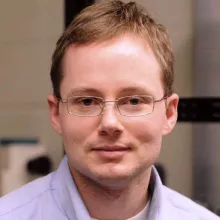Scalable construction of hybrid quantum photonic cavities
Andrew S. Greenspon, Mark Dong, Ian Christen, Gerald Gilbert, Matt Eichenfield, Dirk Englund
Nanophotonic resonators are central to numerous applications, from efficient spin-photon interfaces to laser oscillators and precision sensing. A leading approach consists of photonic crystal (PhC) cavities, which have been realized in a wide range of dielectric materials. However, translating proof-of-concept devices into a functional system entails a number of additional challenges, inspiring new approaches that combine: resonators with wavelength-scale confinement and high quality factors; scalable integration with integrated circuits and photonic circuits; electrical or mechanical cavity tuning; and, in many cases, a need for heterogeneous integration with functional materials such as III-V semiconductors or diamond color centers for spin-photon interfaces. Here we introduce a concept that generates a finely tunable PhC cavity at a select wavelength between two heterogeneous optical materials whose properties satisfy the above requirements. The cavity is formed by stamping a hard-to-process material with simple waveguide geometries on top of an easy-to-process material consisting of dielectric grating mirrors and active tuning capability. We simulate our concept for the particularly challenging design problem of multiplexed quantum repeaters based on arrays of cavity-coupled diamond color centers, achieving theoretically calculated unloaded quality factors of 10^6, mode volumes as small as 1.2 (lambda/neff)^3, and maintaining >60 percent total on-chip collection efficiency of fluorescent photons. We further introduce a method of low-power piezoelectric tuning of these hybrid diamond cavities, simulating optical resonance shifts up to ~760 GHz and color center fluorescence tuning of 5 GHz independent of cavity tuning. These results will motivate integrated photonic cavities toward larger scale systems-compatible designs.
CQN Authors

Matthew Eichenfield
SPIE Endowed Chair in Optical Sciences, Associate Professor, Distinguished Member of the Technical Staff (Physics) and CINT Scientist: Sandia National Laboratories
University of Arizona, Wyant College of Optical Sciences

Dirk Englund
CQN Co-Deputy Director, Associatee Professor of EECS
Massachusetts Institute of Technology, Electrical Engineering & Computer Science
